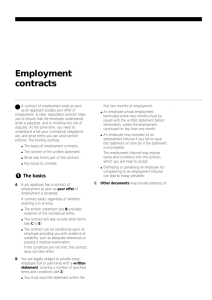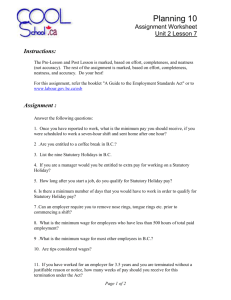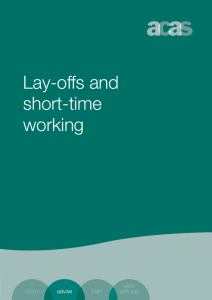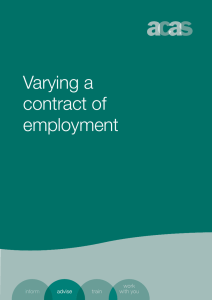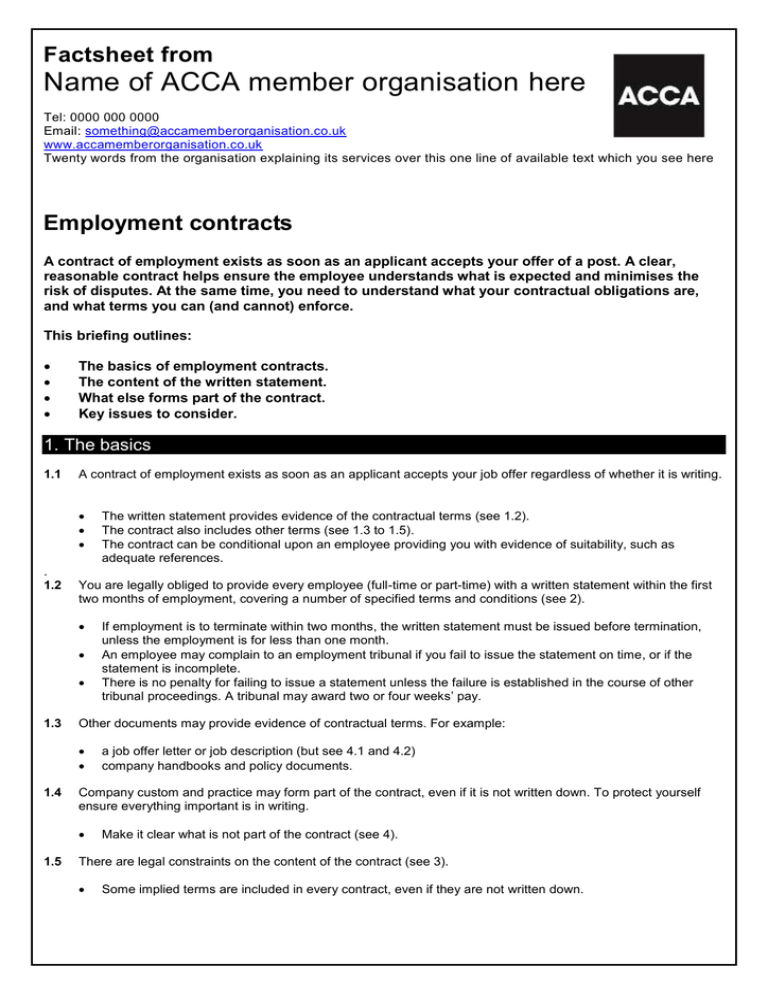
Factsheet from
Name of ACCA member organisation here
Tel: 0000 000 0000
Email: something@accamemberorganisation.co.uk
www.accamemberorganisation.co.uk
Twenty words from the organisation explaining its services over this one line of available text which you see here
Employment contracts
A contract of employment exists as soon as an applicant accepts your offer of a post. A clear,
reasonable contract helps ensure the employee understands what is expected and minimises the
risk of disputes. At the same time, you need to understand what your contractual obligations are,
and what terms you can (and cannot) enforce.
This briefing outlines:
The basics of employment contracts.
The content of the written statement.
What else forms part of the contract.
Key issues to consider.
1. The basics
1.1
A contract of employment exists as soon as an applicant accepts your job offer regardless of whether it is writing.
.
1.2
You are legally obliged to provide every employee (full-time or part-time) with a written statement within the first
two months of employment, covering a number of specified terms and conditions (see 2).
1.3
a job offer letter or job description (but see 4.1 and 4.2)
company handbooks and policy documents.
Company custom and practice may form part of the contract, even if it is not written down. To protect yourself
ensure everything important is in writing.
1.5
If employment is to terminate within two months, the written statement must be issued before termination,
unless the employment is for less than one month.
An employee may complain to an employment tribunal if you fail to issue the statement on time, or if the
statement is incomplete.
There is no penalty for failing to issue a statement unless the failure is established in the course of other
tribunal proceedings. A tribunal may award two or four weeks’ pay.
Other documents may provide evidence of contractual terms. For example:
1.4
The written statement provides evidence of the contractual terms (see 1.2).
The contract also includes other terms (see 1.3 to 1.5).
The contract can be conditional upon an employee providing you with evidence of suitability, such as
adequate references.
Make it clear what is not part of the contract (see 4).
There are legal constraints on the content of the contract (see 3).
Some implied terms are included in every contract, even if they are not written down.
1.6
Contracts cannot override certain statutory rights. However, employees adopting employee-owner or
employee-shareholder status forego some of their statutory employment rights in exchange for shares in the
company. See box, page 3
You cannot change the employment contract unilaterally.
Consult employees and get their agreement before changing their terms and conditions.
Altering terms and conditions without the employee’s consent is a breach of contract. This could lead to a
complaint of constructive dismissal (unless the change is clearly advantageous to the employee).
If you wish to change any of the terms and conditions, you must notify the employee in writing within a month
of the change.
2. Written statement
You can provide a single written statement covering all the terms; or a ‘principal statement’ (see 2.1), together with
further instalments covering the other specified terms and conditions (see 2.2–2.4). The statement must cover all the
specified terms and conditions, even if they do not apply.
2.1
The principal statement must contain:
The names of the employer and employee.
The date when the employment began.
The date on which the period of continuous employment began (this may include previous employment with
a related employer).
The employee’s scale or rate of pay (or how it is calculated) and the intervals at which wages or salary will
be paid.
Information about working hours (start and finish times, shift patterns, meal breaks, rest days, overtime and
overtime payments, etc).
Holiday entitlement (including bank and public holidays) and holiday pay.
This must provide enough information to work out the employee’s entitlement to accrued holidays and holiday
pay on termination of employment.
The employee’s job title (or a brief description of the work for which the person was employed).
The employee’s place of work.
If the employee is required or permitted to work in various places, the statement should include an indication to
that effect and a note of the employer’s address.
2.2
The principal statement or some other readily accessible documents must also include:
2.3
The statement should include a note on disciplinary procedures, including:
2.4
information on discipline (see 2.3) and grievance procedures (see 2.4)
any terms and conditions relating to incapacity for work, including any provision for sick pay (other than
statutory sick pay)
any terms and conditions relating to pensions and pension schemes, including whether or not the pension
scheme is ‘contracted out’
the length of notice which the employee is obliged to give and entitled to receive to terminate the contract of
employment
the intended period of employment or the date when it will end (unless the post is permanent)
any collective agreements which directly affect the terms and conditions of employment.
What the procedures are. These must be fair and reasonable – it is advisable to follow the Acas Code of
Practice.
The statement should include a note on grievance procedures, including:
2
The individual (by name or job title) the employee should contact with any employment grievance, and how
to do so.
What the procedures are . These should be fair and reasonable – it is advisable to follow the Acas Code of
Practice.
3. Other contractual terms
Every contract includes implied terms, whether they are written down or not (see 3.1 and 3.2). In addition, no contract
can override certain statutory rights (see 3.3). Employers have a duty to provide employees with information
concerning their rights.
3.1
Employers must:
3.2
Employees must:
3.3
provide a secure, safe and healthy working environment which includes provision for safe working methods
and appropriate health and safety training
not take any action which may undermine the relationship of ‘trust and confidence’ with their employees
ensure that an employee's grievances will be dealt with promptly and properly.
serve the employer honestly and faithfully
not compete with the employer’s business
not divulge confidential information (see 5.7)
obey reasonable and lawful instructions
work with due diligence and skill and take reasonable care of the employer's property.
Employees’ statutory rights include:
a minimum period of notice
rights under anti-discrimination laws
the right to be, or not to be, a member of any particular trade union
rights under legislation relating to working time and pay.
Contractual terms which attempt to override these rights may be void and unenforceable.
In addition, various laws restrict who you can employ. For example, there are restrictions on employing non-EU
workers and children. If you are in any doubt, ask your legal adviser.
4. Non-contractual terms
4.1
Any job offer can become a contractual obligation.
4.2
Make it clear at interview that you are not offering a job at this stage.
Ensure that any job offer letter states the contract will be governed by written terms and conditions.
Include the written statement of terms and conditions.
Provide job descriptions which allow you the maximum flexibility.
Include a statement that you reserve the right to amend or add to job descriptions.
For example, to accommodate any restructuring of the business.
Reserve the right to change the employee’s place of work. If you do not, you may be in breach of contract if
the business is relocated and you try to get employees to move to new premises.
Even if you do this, an employee may be able to claim a ‘place of work’ redundancy.
3
4.3
Make it clear if you intend benefits to be non-contractual (and therefore easier to amend or withdraw). For
example discretionary bonuses.
.
Identify them as ‘non-contractual benefits’ in the written statement. Explicitly state that you reserve the right
to alter or withdraw them.
If employees come to have ‘reasonable’ expectations of receiving a benefit, an employment tribunal or court
is likely to interpret it as a contractual entitlement.
It is good practice to give reasonable notice of your intention to withdraw or alter any benefits, and to discuss
your plans with employees.
4.4 Give yourself some flexibility on disciplinary rules and procedures.
It is advisable to follow the Acas code of practice.
Make it plain you intend to be consistent in dealing with problems, but reserve the right to enter the discipline
process at different stages, depending on the offence.
Give some examples of how offences might be handled, but make it plain they are only examples.
5. Common issues
5.1
There are legal restrictions on working hours.
There are detailed regulations regarding minimum daily and weekly rest periods, maximum weekly hours,
paid holidays and health assessments for night workers.
These regulations are complex and you should take legal advice if you have particular concerns.
5.2
Entitlement to annual holiday must be set out in the written statement.
Employees are entitled to a minimum of 5.6 weeks’ paid annual leave pro rata. A minimum of four weeks'
holiday must be taken. The remainder can often be rolled over to the next year.
5.3
In general, you are not entitled to make deductions from an employee’s pay without a prior written arrangement,
or you are required to do so by law.
5.4
Dismissing an employee may give rise to a claim for unfair dismissal, breach of contract, or both.
5.5
Make sure the contract clearly states the grounds on which you can terminate the employment without
notice, or with a payment in lieu of notice.
Even in cases of gross misconduct, you must comply with statutory requirements and follow a fair procedure.
Benefits must be provided on a basis that does not discriminate, either directly or indirectly, between
employees on a wide range of grounds including sex andage, or between part-time and full-time employees.
This applies whether they are contractual or non-contractual.
The terms and conditions on which benefits are provided should be spelled out clearly and unequivocally.
Even discretionary payments can lead to a claim of unlawful discrimination.
5.6
The employer normally owns the rights to any intellectual property created by an employee in the course of
employment. This should be written into the contract.
5.7
Confidentiality clauses should be included in the contracts of those with access to sensitive information.
Employees are under an implied duty not to divulge trade secrets, both during employment and after it has
ended.
Set out clearly in the written contract what you consider to be confidential.
5.8
Preventing ex-employees from competing with you is difficult.
4
To prevent an ex-employee from setting up in competition, express terms will need to be included in the
contract.
To be valid, they must be reasonable. For example, any such restriction must only cover a specified period and
area.
You may also want to prevent ex-employees from targeting your customers or recruiting senior staff.
If challenged, you will have to prove that restrictions go no further than necessary to protect your legitimate
business interests.
You will not be able to enforce any ‘post-termination clauses’ if you are in breach of contract.
Take legal advice if you have any specific concerns.
Employee-shareholder contracts
The Government has launched a new form of employment status — known as employee-shareholder or
employee-owner contracts.
A
Employers give employees shares in the business worth between £2,000 and £50,000.
B
Employee-shareholders give up a range of employment rights in return for the shares. They:
are not entitled to statutory redundancy pay
do not have the right to request flexible working (except on return from parental leave) or for time off for
training
do not have ordinary ‘unfair dismissal protection’
must give 16 weeks’ notice to return early from maternity or adoption leave (instead of the usual eight).
Companies can opt to give employee-shareholders more generous employment conditions.
C
Employee-shareholder contracts can be used by companies of any size.
They are optional for existing employees.
Companies can choose to offer only employee-shareholder contracts for new employees.
Working abroad
If an employee will be required to work outside the UK for more than one month, the written statement must also
include:
A.
How long the employee will be required to work outside the UK.
B.
What currency the employee is to be paid in.
C.
What additional remuneration or benefits (if any) will be paid or provided.
D.
Any terms and conditions relating to the employee’s return to the UK.
Employees must be given a written statement before leaving the UK, if they are due to work abroad within two months
of taking up their post.
Employees working outside the UK can, in some circumstances, have employment relationships so closely connected
with the UK that they are entitled to the same rights (eg unfair dismissal) as UK-based workers .
Note
5
Employment law is complex and is changing rapidly. This briefing reflects our understanding of the basic legal position
as known at the last update. Obtain legal advice on your own specific circumstances and check whether any relevant
rules have changed.
Acas publishes a guide called ‘Contracts of employment’ (08457 47 47 47 or www.acas.org.uk).
Experts’ quotes
“If your employment contracts don’t set out a notice period, senior employees will often be able to claim more than the
statutory maximum of 12 weeks’ notice if they are dismissed. But if they resign they will never have to give more than a
week’s notice.”
Tim Russell,
Norton Rose solicitors
“A written statement of terms of employment may not in itself be a contract of employment (unless that was clearly the
intention of the parties). However, it will always be useful evidence of the contractual terms.”
Jim Givens,
HR Management Solutions
Expert contributors
Thanks to Jim Givens (HR Management Solutions, 01695 421980, www.humanresourcesclick.net); Tim Russell
(Employment Law Consultant and part-time Employment Tribunal Chair, 07767 646 656).
Last updated 01.10.13
© Atom Content Marketing 2013. ISSN 1369-1996. All rights reserved. No part of this publication may be reproduced or transmitted without the
written permission of the publisher. This publication is for general guidance only. The publisher, expert contributors and distributor disclaim all liability
for any errors or omissions. Consult your local business support organisation or your professional adviser for help and advice.
6

